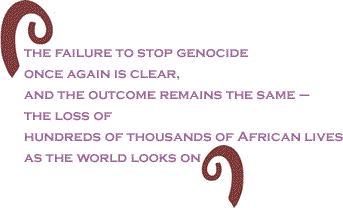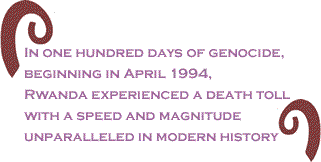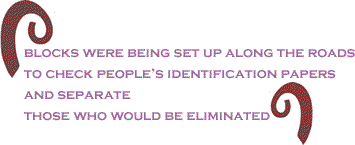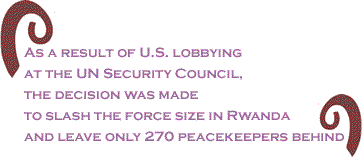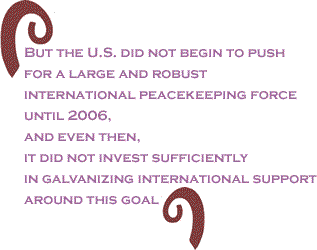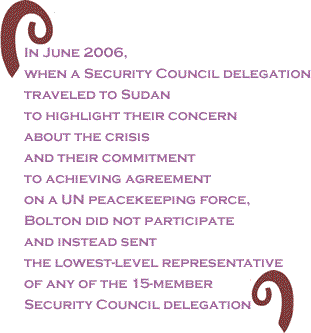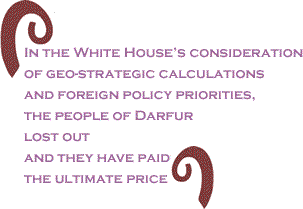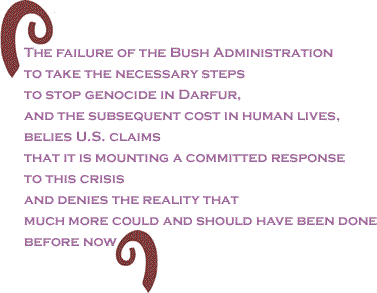
|
|||||||||||||||||||||
 |
|||||||||||||||||||||
 |
|||||||||||||||||||||
 |
|||||||||||||||||||||
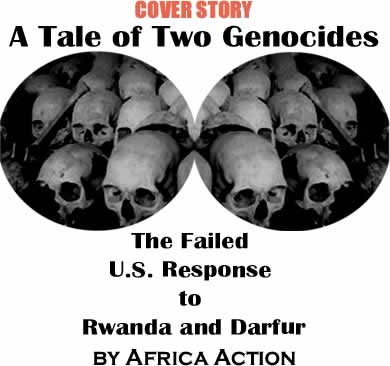 |
|
This report was written by Ann-Louise Colgan, with valuable contributions from Diana Duarte. Additional research support was provided by Petra Stankard and was produced by Africa Action, with partial support from American Jewish World Service (AJWS). The views and conclusions expressed in this report reflect those of Africa Action, and not necessarily those of AJWS. $Africa Action is the oldest Africa advocacy organization in the U.S. Its mission is to change U.S. Africa relations to promote political, economic and social justice in Africa. Africa Action provides accessible information and analysis, and mobilizes popular support for campaigns to achieve this mission. On September 9, the two-year anniversary of the Bush Administration’s recognition that genocide is occurring in Darfur, Africa Action joined with hundreds of activists for a rally and act of civil disobedience in front of the White House. During the rally, participants made their mark of witness with red handprints to represent the victims of the genocides in Rwanda and Darfur. This gathering emphasized the urgent need for concerted efforts by the U.S. to remove the obstacles to the deployment of a United Nations (UN) peacekeeping force to protect the people of Darfur. INTRODUCTIONIn 1994, an estimated 800,000 people died in Rwanda, as the U.S. and the international community failed to mount an intervention to stop genocide. Senior U.S. officials later expressed regret, and acknowledged that this crime against humanity should have invoked a more urgent and active response. It is reported that President Bush reviewed a memo on the Rwandan genocide early in his presidency and wrote “Not on my Watch” in the margin of that document.[1] Less than a decade after the Rwandan genocide, the U.S. was faced with another unfolding genocide in Africa, this time in Darfur, western Sudan. In early 2003, the government of Sudan and its proxy militias unleashed a scorched earth campaign, targeting civilians from three African communities in Darfur and causing untold death and destruction. More than three years later, the Darfur genocide is continuing on the Bush Administration’s watch. The U.S. has again failed to take the action necessary to stop the violence and protect civilians from genocide. The dynamics are different on the ground and internationally, and the level of engagement among policymakers and the public is different in this case, too. But the failure to stop genocide once again is clear, and the outcome remains the same – the loss of hundreds of thousands of African lives as the world looks on. This report by Africa Action identifies patterns in the U.S. response to the Rwandan genocide in 1994 and to the current genocide in Darfur, Sudan. It explores the similarities and differences in the reaction of U.S. policymakers and the American public, and it examines the important lessons the U.S. has yet to learn. Finally, Africa Action lays out in this report the actions needed now from the U.S. to stop the genocide in Darfur. It underscores the possibility and necessity of a more urgent and effective U.S. response to this genocide, and the obligation of the entire international community to assert its responsibility to protect the people of Darfur. This Africa Action report is released on September 9, 2006 to mark the two-year anniversary of the Bush Administration’s acknowledgement that what is happening in Darfur constitutes genocide. The passage of this anniversary and the continuation of the genocide in Darfur indicate the inadequacy of U.S. policies in response to this crisis. THE UNITED STATES AND GENOCIDE IN RWANDAIn one hundred days of genocide, beginning in April 1994, Rwanda experienced a death toll with a speed and magnitude unparalleled in modern history. In a carefully planned and nearly successful attempt to eliminate the Tutsi minority, the Hutu-controlled government incited masses of the Hutu population to take up arms against those deemed enemies of the state. As a result, an estimated 800,000 Tutsi and moderate Hutu were killed.[2]
Today, the world recognizes the shamefully inadequate international response to the genocide in Rwanda. The United Nations (UN) observes a Day of Remembrance for this genocide’s victims, and numerous world leaders have repeated the mantra of “never again.” However, as the violence unfolded on the ground twelve years ago, the international community stood silently by, and key leaders such as the United States maneuvered to avoid direct engagement and to limit any robust response to stop the killing. What the U.S. KnewDuring President Bill Clinton’s trip to Africa in 1998, he stopped in Kigali, Rwanda, to deliver an apology for not having done “as much as we could” to stop the genocide in 1994. He announced to an audience at the Kigali airport, “[A]ll over the world there were people like me sitting in offices, day after day after day, who did not fully appreciate the depth and the speed with which you were being engulfed by this unimaginable terror.”[3] In fact, there exists a great deal of evidence to suggest that detailed information on the scope of the genocide was indeed available to the U.S. – both before and during the massacres in Rwanda. Reports suggesting a high likelihood of massive ethnic violence had been available even during the early 1990s. In January 1994, U.S. intelligence analysts had predicted that in case of renewed conflict in Rwanda, “the worst-case scenario would involve one half million people dying.”[4] In the final analysis, even these dire forecasts proved to be conservative. On April 6, 1994, the same day that Rwandan President Habyarimana’s plane was shot down and the crisis began to unfold, Deputy Assistant Secretary for African Affairs Prudence Bushnell drafted an urgent memo to Secretary of State Warren Christopher. In it, she warned that the assassination could prompt an outbreak of killings, and she urged the U.S. to appeal for calm.[5] Within days, Joyce Leader, Deputy Chief of Mission stationed in Rwanda, realized that a pattern of clear and systematic killing of Tutsi had emerged.[6] Lists of the names of Tutsi and some Hutu targets had been compiled and distributed, and blocks were being set up along the roads to check people’s identification papers and separate those who would be eliminated. Recognizing the extreme danger on the ground, the U.S. made the decision to evacuate all American citizens from Rwanda. By April 10, 1994, the U.S Ambassador to Rwanda David Rawson and 250 American citizens had been evacuated from the country.[7] Memos prepared for U.S. officials in subsequent days warned of a massive and impending “bloodbath”.[8] Though fully briefed on the unfolding crisis, the Clinton Administration took no action to halt the growing violence, and instead began to lobby for the withdrawal of the UN force in Rwanda.[9]
As it continued to monitor the situation, the State Department convened daily interagency meetings, also featuring representatives from the Pentagon, the National Security Council, and the wider intelligence community.[10] In the following weeks, U.S. intelligence and defense reports repeated similar messages, warning of a worsening crisis and growing death toll in Rwanda. On April 26, 1994, an intelligence memo named individuals responsible for organizing the violence and warned of their intent to exterminate the Tutsi population. On May 9, 1994, a Defense Intelligence Agency report discounted the notion that these massacres were spontaneous and instead pointed the finger at the Rwandan government, which was clearly targeting lists of people for destruction.[11] During the weeks in which the genocide unfolded, staff within the administration and in the intelligence community were steadily confronted with irrefutable evidence. The U.S. made an informed decision in choosing not to act to stop the genocide in Rwanda. What the U.S. DidIn a February 2004 interview, Madeleine Albright commented on her role at the time as the U.S. ambassador to the UN. She stated, “I have reviewed the record a lot, and I don't think actually that we could have done more. I just wish that it had not been something that the international community was not capable of dealing with. So it's a huge regret.”[12] It is clear, however, that the U.S. could indeed have done more. In the face of U.S. intelligence clearly demonstrating the rapidly escalating violence, the question was not one of U.S. inability to respond, but one of a lack of political will. A great effort was made to ensure that the U.S. would avoid any direct involvement, and particularly any military commitment, in Rwanda. This priority not only led to deliberate inaction on the part of the Clinton Administration, but also to proactive blocking of international efforts to save lives. Under the pretext that the reputation of peacekeeping was suffering due to recent public failures, the U.S. lobbied to have the UN force in Rwanda, UNAMIR, either removed or drastically reduced. Administration officials apparently feared that increased UN peacekeeping would eventually require some U.S. troop commitment. They actively supported a UN withdrawal from Rwanda even as the genocide was underway.[13] As a result of U.S. lobbying at the UN Security Council, the decision was made to slash the force size in Rwanda and leave only 270 peacekeepers behind.[14] This action left the people of Rwanda without any international protection from the genocide. The Clinton Administration promised to support an arms embargo, and to work towards the renewal of the peace process, but this rhetoric produced no change on the ground. U.S. officials acknowledged that an arms embargo would essentially be useless in the face of a genocide carried out mainly with machetes and other farm implements.[15] There also seemed little chance of a return to the negotiating table in the midst of such bloodshed in Rwanda. The lack of real U.S. engagement on Rwanda was clear. Demonstrating the dearth of high-level attention, President Clinton did not devote a single meeting of his senior foreign policy advisors to devising U.S. options for action on the crisis.[16] Some low- and mid-level officials, recognizing the lack of top-level support for larger engagement, sought more moderate tactics to lessen the death toll. One suggestion was to jam the hateful radio transmissions, which were inciting the general population to take up arms. This proposal was rejected as a costly endeavor that would have too little effect.[17]
As the weeks of violence dragged on, U.S. officials consciously and consistently evaded the use of the term “genocide,” for fear of invoking a responsibility to act.[18] Spokespeople for the administration were challenged repeatedly on this question. They were, in fact, instructed as to the precise language approved for use by the U.S. State Department. At the same time, a message from a U.S. political advisor to the State Department in late April stated that the events in Rwanda clearly met the definition of genocide laid out in the 1948 Convention on the Prevention and Punishment of the Crime of Genocide. This message warned that acknowledging this publicly might force the UN Security Council to act. U.S. decisions and statements were carefully orchestrated to evade any such responsibility to act, even as many U.S. officials privately recognized the extent of the crisis and the need for international action in response. On June 7, 1994, President Clinton stated that humanitarian aid was all that the U.S. could provide to Rwanda, in light of other American military commitments in Europe and Asia. Later that month, the President defended the U.S. response on Rwanda to Members of Congress who requested troop deployment. The President cited U.S. payment for medical supplies and its pressure for a cease-fire as evidence of a strong U.S. response to the crisis.[19] In July 1994, President Clinton finally announced the provision of humanitarian relief for Rwanda, and requested emergency funding from Congress for this effort.[20] By this time, the genocide had essentially been completed, and some 800,000 Rwandan lives had been lost. What Influenced the U.S. ResponseWhen the genocide occurred in Rwanda in 1994, the U.S. administration was still recovering from the incident the previous year in Somalia, when eighteen American soldiers had been killed during a U.S.-sponsored humanitarian intervention. Many officials believed that the American population was unwilling to stomach any more U.S. casualties abroad, and that there were insufficient U.S. interests in Rwanda to warrant another military commitment in Africa. Meanwhile, there seemed to be no domestic movement invested in this issue and pressuring the U.S. leadership to stop the genocide in Rwanda. Representatives of a leading human rights organization lobbying for greater U.S. commitment on the crisis were told by National Security Advisor Anthony Lake: “If you want to make this move, you will have to change public opinion. You must make more noise.”[21] There seemed to be no concerted “noise” forthcoming.
After the genocide was over, Senator Paul Simon famously said, “If every member of the House and Senate had received 100 letters from people back home saying we have to do something about Rwanda, when the crisis was first developing, then I think the response would have been different."[22] In the absence of such public activism, the U.S. did not feel compelled to act. As far as U.S. officials in the Clinton Administration were concerned, there was no political cost to inaction against the Rwandan genocide, as opposed to a potentially steep political cost to U.S. embroilment in yet another violent African quagmire. This appears to have been the final determination of U.S. policy toward Rwanda, even as the human cost of inaction became devastatingly clear. THE UNITED STATES AND GENOCIDE IN DARFURThe ongoing genocide in Darfur marks the first genocide of the 21st century, and the first the world has faced in Africa since Rwanda in 1994. It began in early 2003, when the government of Sudan and its proxy militias (known as the Janjaweed) launched a campaign of genocide against three African communities – the Fur, the Zaghawa and the Massaleit – in Darfur, because rebel groups from that region had risen up to challenge Khartoum’s authoritarian rule and their own marginalization. Three and a half years later, the genocide in Darfur continues today. Some 500,000 lives have been lost,[23] with millions more Darfuris left homeless and facing a growing man-made humanitarian crisis, which forms part of this genocide. Although there has been some U.S. engagement on this crisis, largely prompted by a groundswell of activism nationwide, the Bush Administration has failed to take the action necessary to stop the violence and protect the people of Darfur. What the U.S. SaidTwo years ago today (September 9, 2004), the Bush Administration acknowledged that what is happening in Darfur constitutes genocide. This announcement was the result of political pressure from Congress and citizen pressure from across the U.S. The legal finding was itself based on overwhelming evidence from a study of the region completed by the State Department the previous month.[24] In his testimony before the Senate Foreign Relations Committee on September 9, 2004 then-Secretary of State Colin Powell first used the word “genocide” to describe the crisis in Darfur, and he identified the government of Sudan and the Janjaweed as the perpetrators. A White House statement later that day confirmed this determination.[25] Despite this acknowledgment of genocide, however, the administration immediately ruled out any urgent response to what was happening in Darfur. In his same testimony on September 9, Secretary Powell declared, “no new action is dictated by this determination.”[26]
Two weeks later, President Bush addressed the UN General Assembly, reiterating the U.S. position that genocide was occurring in Darfur, but urging no new international action to address it.[27] Though President Bush claimed to be “appalled by the violence” in Darfur, and though he asserted that only outside action could stop the violence,[28] no such action was initiated by the U.S. in response to the genocide. Other than a brief response to a question on Darfur posed to the President during the election debates in October,[29] the White House would remain silent on the crisis for months thereafter. In early 2005, as the crisis in Darfur deepened, senior officials at the State Department, including Deputy Secretary of State Robert Zoellick, began to evade media questions on Darfur and backed away from using the term “genocide.” A spokesperson at the White House defended the apparent lack of engagement by the U.S. on Darfur, stating that the President had “more pressing priorities” than this crime against humanity.[30] In June 2005, President Bush responded to growing pressure from advocates and from the media by breaking his months-long silence on Darfur. He reiterated the U.S. position that genocide was occurring but suggested no new plan to stop the violence.[31] As the situation on the ground continued to deteriorate in late 2005 and into 2006, the President and senior administration officials spoke out more frequently on Darfur, seeking to ward off criticism and respond to growing activism on this crisis. But their words were not matched with action. The death toll in Darfur continued to mount, even as top-level officials repeatedly claimed that the U.S. was doing everything possible to stop the genocide. In a television interview in February 2006, Vice President Dick Cheney said on Darfur: “I am satisfied we are doing everything we can do.”[32] In May 2006, in testimony before the House International Relations Committee, Assistant Secretary of State for African Affairs, Jendayi Frazer, declared Darfur to be “a top priority for…elected officials”, and emphasized “the Administration is working diligently toward a resolution.”[33] But these statements rang hollow in the absence of U.S. action to stop the violence. A White House fact sheet on Darfur in May 2006 said that the President maintained that what was happening in Darfur genocide because “no other word captures the extent of this tragedy.”[34] But this fact sheet was created twenty months after the U.S.’ recognition of genocide in Darfur, and the violence was worsening without action to stop it. What the U.S. DidThe U.S. response to the genocide in Darfur has involved engagement in some aspects of the crisis, in an attempt to mitigate the humanitarian crisis and promote a long-term solution. But on the most immediate priority of stopping the violence and providing protection to the people of Darfur, the U.S. has failed to articulate or pursue a successful plan of action. The U.S. has provided significant financial support for humanitarian efforts in Darfur, where the largest humanitarian operation in the world struggles to cope with growing numbers of people in need. As aid agencies have increasingly voiced concerns about the dangerous conditions on the ground, and have been forced to take measures to curtail their operations at certain moments, the U.S. has helped to fund their operations but has failed to tackle the growing violence and insecurity they face. In the first three years of the genocide, the U.S. provided $1 billion in humanitarian aid for Darfur, helping to sustain millions of people left dependent on international assistance.[35] The U.S. did not, however, take steps to directly address the worsening security situation or to protect civilians and humanitarian operations on the ground.
The U.S. also made a diplomatic investment in the Abuja peace talks, sponsored by the African Union (AU). The administration repeatedly expressed its commitment to a “political solution” to the ongoing crisis in Darfur. Senior U.S. officials, particularly Deputy Secretary of State Zoellick, traveled a number of times to Khartoum and to Abuja, Nigeria. However, occasional trips and periodic remarks about U.S. engagement failed to substitute for assertive international leadership to stop the genocide. In fact, the signing of the Darfur Peace Agreement in May 2006, which was heavily promoted by the U.S., actually led to a spike in violence in subsequent months. As AU officials condemned the striking increase in violence and civilian casualties in the summer of 2006,[36] the U.S. and international response failed to address the deteriorating situation on the ground. The “hands off” U.S. strategy on Darfur was initially framed by the administration as deference to the African Union, which had shown some leadership on the crisis and had deployed a small mission to the region. In fact, the AU was essentially abandoned by the international community to deal with the growing crisis. While it was clear that the African Union’s mission in Darfur lacked the troop size, the mandate and the logistical capacity to stop the genocide and protect the people, the U.S.’ limited financial and logistical support for the AU was described by the Bush Administration as a central element of its response to the crisis. The U.S. offered transport planes to bring AU troops to Darfur, it worked with NATO members to provide planning and logistical assistance and intelligence support to the AU, and it committed some funding to extend the life of the AU operation. But it was already abundantly clear that a larger international intervention was required, if this genocide was to be stopped. At the international level, the U.S. introduced or supported numerous UN Security Council resolutions on Darfur, condemning the violence, urging an end to atrocities, and even imposing some limited sanctions on those perpetrating war crimes and crimes against humanity. But the U.S. did not begin to push for a large and robust international peacekeeping force until 2006, and even then, it did not invest sufficiently in galvanizing international support around this goal. Although the Bush Administration described itself as a leader on Darfur, and although it had affirmed the September 2005 UN commitment of a “Responsibility to Protect” civilians against crimes against humanity such as genocide,[37] the U.S. failed to take the necessary action to stem the bloodshed in Darfur. Within the UN, U.S. Ambassador John Bolton claimed in 2006 to have built up a strong track record on the crisis in Darfur,[38] though his actions revealed otherwise. In October 2005, Bolton joined with representatives from China, Russia and Algeria in blocking the UN Special Adviser on the Prevention of Genocide, Juan Mendez, from briefing the Security Council on human rights violations in Darfur. In February 2006, when the U.S. held the rotating presidency of the Security Council, Bolton issued a rhetorical “Presidential Statement” rather than seeking to galvanize Security Council support for action in the form of a resolution authorizing a peacekeeping mission for Darfur. In June 2006, when a Security Council delegation traveled to Sudan to highlight their concern about the crisis and their commitment to achieving agreement on a UN peacekeeping force, Bolton did not participate and instead sent the lowest-level representative of any of the 15-member Security Council delegation.[39] In the summer of 2006, as the situation in Darfur deteriorated still further, there finally emerged an international consensus around the need for a UN peacekeeping force to stop the violence and restore security. This notion received public support from the U.S., the UN Secretary-General, most members of the UN Security Council, the AU, the leadership of the Arab League, and dozens of organizations and millions of public citizens. The UN Secretary-General presented recommendations to the Security Council on the necessary size, mandate, scope and logistical capacity of a future UN peacekeeping mission for Darfur, with the remaining obstacle being Khartoum’s opposition to such a mission.[40]
At the writing of this report, a new resolution passed at the Security Council promised new momentum on Darfur, but as yet the deployment of a UN force remains stalled. As the government of Sudan continues to reject the prospect of a UN peacekeeping mission, the need for U.S. leadership and action is paramount. The ongoing failure of the U.S. to take effective steps to break the international deadlock, overcome Khartoum’s opposition, and achieve a UN peacekeeping mission for Darfur continues to reveal a lack of serious engagement in resolving this crisis. What Influenced the U.S. ResponseThe crisis in Darfur has generated unprecedented citizen activism across the U.S. A diversity of groups and people of conscience from all faiths and backgrounds have become engaged in advocacy and activism on Darfur, raising awareness of the genocide and promoting a more urgent U.S. response. These citizen voices, and the media attention which they have commanded, have influenced the administration’s response, evoking pledges of commitment and some new engagement. Numerous rallies and events held around the country, and millions of communications sent to policymakers by constituents, have raised the profile of this issue and demanded U.S. action. This activism was part of what led the White House to call this “genocide” in 2004, and it has continued to drive the U.S. engagement on this issue. Other factors also seemed to argue for greater U.S. action on Darfur. Comments made by the President and other senior officials indicated a rhetorical commitment to avoiding the mistakes made during the Rwandan genocide, and asserted the “Responsibility to Protect” civilians. In addition, the UN Security Council proved to be amenable to passing numerous resolutions on Darfur, and the long timeline of this crisis allowed ample opportunities to overcome obstacles and promote new action. But other, more powerful factors and competing priorities apparently negated these potential motivators for U.S. action. At the time when the Darfur genocide began, the U.S. was involved in promoting a peace settlement in Sudan in the long-running civil war between the government in the North and the people of the South. The official relationship between the U.S. and Sudan appeared to be on the path towards a thaw, after an isolationist approach to Khartoum by Washington in the 1990s as a result of Sudan’s hosting of Al Qaeda. After the terrorist attacks of September 11, 2001, Khartoum invited an intelligence-sharing relationship with the U.S. in the context of the so-called “War on Terrorism.”[41] The conclusion of the Comprehensive Peace Agreement (CPA) between North and South in Sudan was considered a diplomatic victory for the U.S., but also coincided with the beginning of the government-sponsored genocide in Darfur. The U.S. support for the CPA, its intelligence-sharing relationship with Khartoum, and the mutual desire to move towards the normalization of economic and political relations between the countries were policy priorities that were considered to have undermined a more robust U.S. response on Darfur. Ironically, at the same time, these interests and ties between Washington and Khartoum provided the Bush Administration with clear leverage and opportunities to push Sudan to stop the genocide and allow UN peacekeepers into Darfur. As the international community stalled in overcoming Khartoum’s objections to a UN force, the U.S. could have done much more to challenge the Sudanese government and find a way forward on Darfur.
It is also clear that the U.S. could have invested sooner and more deeply in international diplomacy on Darfur, to help mobilize new action on this crisis. But the Bush Administration wished to retain its international leverage and its political capital for other concerns, in the Middle East and in the larger so-called “War on Terrorism.” In the White House’s consideration of geo-strategic calculations and foreign policy priorities, the people of Darfur lost out and they have paid the ultimate price. LESSONS YET TO LEARNIn Rwanda in 1994, the Clinton Administration refused to name the unfolding genocide. The U.S. also failed to act to stop it. It blocked international intervention in Rwanda, claiming that there was no domestic constituency nor compelling foreign policy interest to support U.S. action on this crisis. The U.S. failures on Rwanda, summarized in this report, have been well documented elsewhere. In Darfur, the Bush Administration remains the only government to have publicly acknowledged that what is happening constitutes genocide. But this declaration has not galvanized official U.S. action sufficient to stop the violence on the ground. The U.S. has made some diplomatic investment in the peace process in Darfur, and some financial investment in humanitarian efforts, but it has failed to implement a successful strategy to protect the people of Darfur from the ongoing genocide. The unprecedented activism across the country has forced rhetorical commitments from the administration, but these have not been followed by concrete actions to improve the security situation in western Sudan. Despite some key differences in the domestic and international dynamics today, compared to twelve years ago during the Rwandan genocide, the U.S. response on Darfur reveals that important lessons remain unlearned. As successive U.S. administrations have been faced with genocide in Africa, each has claimed to be doing everything possible in response. This has been untrue and this assertion is, therefore, disingenuous. The U.S. is the most powerful country in the world, with an unmatched capacity to respond to crises and to mobilize the broader international community’s response. If the U.S. were to do everything it could to stop genocide, it is certain that it would succeed in doing so. Instead, in Rwanda and now in Darfur, the U.S. claims it is fully invested in addressing this crisis, but it is not expending the necessary diplomatic or political resources to achieve an international peacekeeping force, which is the most immediate priority. In Rwanda, the Clinton Administration offered humanitarian assistance but refused to support the necessary intervention in the form of an international peacekeeping force. In Darfur, once again, the Bush Administration has been quite generous in the provision of support to the humanitarian effort, and it has also afforded logistical support to the African Union. But the U.S. has not invested sufficiently in achieving the deployment of the necessary peacekeeping force, to respond to the most urgent priority of protecting the people of Darfur. The crime of genocide, which seeks to destroy a group of people in whole or in part, demands more than a humanitarian response. The international community must be prepared to deploy a peacekeeping force to stop the violence, and must quickly do so in response to such a crisis. This was not a U.S. priority in Rwanda in 1994, and it is clearly not a U.S. priority in Darfur today. In a broader sense, the failed response to Rwanda and now to Darfur indicates a shameful negligence on the part of the U.S. when it comes to saving African lives. In the realm of U.S. foreign policy priorities, Africa is most often absent or marginalized, and the human cost of this myopia is most clear in the death toll of these two genocides. In Rwanda in 1994, the Clinton Administration was more focused on the crisis in the former Yugoslavia, and was still reeling from the disastrous U.S. intervention in Somalia the previous year. In Darfur at present, the U.S. is focused more urgently on the crisis in the Middle East, on the war in Iraq and on the so-called “War on Terrorism”, which are estimated to be more pressing policy priorities than genocide in Africa. There is a clear pattern of a lack of political will on the part of U.S. officials to take action to save African lives. It is hard to imagine another part of the world where genocide would be left to continue, and where the loss of hundreds of thousands of lives would be tolerated. The persistent racism in U.S. foreign policy is clear from the lack of urgency with which the U.S. responds to genocide on the African continent. While in Rwanda, Clinton Administration officials claimed that the genocide happened quickly, that they were ill informed, and that there was insufficient public activism, these excuses cannot be used to explain the U.S. failure to stop the genocide in Darfur. But there is the same lack of political will in both instances. The rhetoric and the profile of the Darfur crisis do not mask the underlying U.S. failure, once again, to save the lives of countless innocent civilians. RECOMMENDATIONSUnlike during the Rwandan genocide, which took place in only three months, the U.S. and the international community have now watched the Darfur genocide play out over several years, with ample time to absorb what was happening, and to identify the possibilities and priorities for action. Although, at the writing of this report, estimates indicate that some 500,000 lives have already been lost in Darfur, Africa Action asserts opportunities and obligations for new action that can still save countless lives. With protection being the clear and immediate priority,
the first step must be the deployment of a UN peacekeeping mission
to the region. The African Union’s leadership on Darfur has been
important, but there exists a larger international responsibility
to act in support of the AU to stop the genocide The establishment of such a peacekeeping mission is entirely consistent with the “Responsibility to Protect” principle, according to which all UN member states agreed in September 2005 that there is an international obligation to protect populations against genocide and other crimes against humanity. The agreement of UN member states that they “are prepared to take collective action, in a timely and decisive manner” to help protect populations from genocide and other such crimes against humanity must now drive their response to the crisis in Darfur.[42] Achieving the deployment of the required UN peacekeeping operation for Darfur, with the necessary size, scope and mandate, involves a special role for the U.S. At the international level, it requires new and urgent action from the U.S. to overcome all remaining obstacles to such a force, and to secure all necessary support from the members of the UN Security Council to move this forward quickly. The U.S. must use its leverage with all stakeholders, including the Sudanese government, to pave the way for the rapid deployment of the requisite UN force. The U.S. must itself be prepared to commit substantial new resources and logistical assistance to the future UN peacekeeping operation in Darfur. The U.S. must also continue to provide generous support to humanitarian assistance programs in Darfur and throughout the region to meet the urgent needs of the people on the ground. While a UN peacekeeping force is not the final answer for Darfur, it is essential to stabilize the situation and protect the vulnerable in the immediate term, and it represents a first step on the path to peace. In responding to genocide, civilian protection is both a priority and an obligation, and this should always trigger urgent international action. CONCLUSIONA decade after failing to stop genocide in Rwanda, and two years ago today, the Bush Administration publicly recognized that genocide was taking place in Darfur, Sudan. This declaration suggested a different and more engaged response than what had been seen in Rwanda. Yet this has not been borne out. The genocide continues in Darfur, and the U.S. has failed to stop the violence or protect civilians on the ground. The achievement of a large and robust international peacekeeping force for Darfur remains elusive without strong leadership and new action. The U.S. claims to be doing all it can on this crisis, but the death toll is mounting and it is clear that much more can and must be done. The most important immediate priority is providing protection to the people of Darfur, and an international peacekeeping force can achieve this. What is missing is the political will on the part of the Bush Administration to overcome remaining obstacles and make this a reality. The U.S. and the international community have been judged harshly for their failures on Rwanda, and world leaders have apologized for their inaction on that genocide twelve years ago. But history will judge current policies on Darfur just as severely. The failure of the Bush Administration to take the necessary steps to stop genocide in Darfur, and the subsequent cost in human lives, belies U.S. claims that it is mounting a committed response to this crisis and denies the reality that much more could and should have been done before now. As the genocide continues in Darfur, it becomes an increasing political liability for the Bush Administration. It is an indictment of the current White House, but it is also a comment on Africa’s place in U.S. foreign policy. Unless we learn the lessons of Rwanda and apply them now in Darfur, we confirm a pattern of negligence that destines the U.S. to repeat these horrific failures in the future. ENDNOTES[1] Philip Gourevitch, “Just Watching,” The New Yorker, 5 June 2006 [2] PBS, Frontline, “The Triumph of Evil: 100 Days of Slaughter” [3] Samantha Power, “Bystanders to Genocide,” The Atlantic Monthly, September 2001 [4] Organization of African Unity, “Rwanda: The Preventable Genocide,” OAU report by International Panel of Eminent Personalities, July 2000 [5] William Ferroggiaro, ed. “The US and the Genocide in Rwanda 1994: Evidence of Inaction,” The National Security Archive at the George Washington University, 20 August 2001. Document #2: “Memorandum from Prudence Bushnell, Principal Deputy Assistant Secretary, Bureau of African Affairs, through Peter Tarnoff, Under Secretary for Political Affairs, to Secretary of State Warren Christopher, ‘Death of Rwandan and Burundian Presidents in Plane Crash Outside Kigali’, April 6, 1994. Limited Official Use.” [6] PBS, Frontline, “Ghosts of Rwanda: Interviews: Joyce Leader” [7] Power, “Bystanders to Genocide.” [8] Ferroggiaro, ed. “The US and the Genocide in Rwanda 1994: Evidence of Inaction,” Document #3: “Memorandum from Deputy Assistant Secretary of Defense for Middle East/Africa, through Assistant Secretary of Defense for International Security Affairs, to Under Secretary of Defense for Policy, “Talking Points On Rwanda/Burundi”, April 11, 1994. Confidential.” [9] Ferroggiaro, ed. “The U.S. and the Genocide in Rwanda 1994: Information, Intelligence and the U.S. Response,” The National Security Archive at the George Washington University, 24 March 2004. Footnote #11: “US Department of State, cable number 94 State 099440, to US Mission to the United Nations, New York, "Talking Points for UNAMIR Withdrawal", April 15, 1994.” [10] Power, “Bystanders to Genocide.” [11] Samantha Power, “A Problem from Hell”: America and the Age of Genocide (New York: HarperCollins Publishers Inc., 2002) 355. [12] PBS, Frontline, “Ghosts of Rwanda: Interviews: Madeleine Albright” [13] Ferroggiaro, ed. “The U.S. and the Genocide in Rwanda 1994: Information, Intelligence and the U.S. Response,” Footnote #11: “US Department of State, cable number 94 State 099440, to US Mission to the United Nations, New York, "Talking Points for UNAMIR Withdrawal", April 15, 1994.” [14] Gerald Caplan, “Why we must never forget the Rwandan Genocide,” Pambazuka News: Weekly Forum for Social Justice in Africa, 1 April 2004 [15] Power, “A Problem from Hell”: America and the Age of Genocide, 371. [16] Power, “Bystanders to Genocide.” [17] PBS, Frontline, “Ghosts of Rwanda: Timeline” [18] Power, “A Problem from Hell”: America and the Age of Genocide, 361. [19] Power, “A Problem from Hell”: America and the Age of Genocide, 377. [20] Chris McGreal, Ian Katz, and Ian Black, “Rwandan Apocalypse,” The Guardian, 23 July 1994. [21] Human Rights Watch, “Remembering Rwanda: Africa in Conflict, Yesterday and Today” (Campaign) [22] Nicholas D. Kristof, “The Secret Genocide Archive,” The New York Times, 23 February 2005 [23] Eric Reeves, “Quantifying Genocide in Darfur (Part 1),” SudanReeves.org, 28 April 2006. [24] “Documenting Atrocities in Darfur,” (State Publication 11182, Released by the Bureau of Democracy, Human Rights, and Labor and the Bureau of Intelligence and Research) September 2004 [25] “President’s Statement on Violence in Darfur, Sudan,” (Statement by the President, Office of the Press Secretary), 9 September 2004 [26] Colin Powell, “The Crisis in Darfur, Testimony Before the Senate Foreign Relations Committee,” 9 September 2004 [27] “Remarks by the President in Address to the United Nations General Assembly,” 21 September 2004 [28] “President’s Statement on Violence in Darfur, Sudan,” 9 September 2004. [29] Commission on Presidential Debates, “2004 Debate Transcript, The First Bush-Kerry Presidential Debate,” 30 September 2004 [30] Guy Dinmore, “White House is quiet as Darfur killings continue,” Financial Times, 14 March 2005. [31] “President and South African President Mbeki Discuss Bilateral Relations” (Oval Office, Office of the Press Secretary), 1 June 2005 [32] PBS, The Newshour with Jim Lehrer, “Newsmaker: Vice President Dick Cheney,” 7 February 2006 [33] Jendayi Frazer, “Prospects for Peace in Darfur, Testimony Before the House International Relations Committee,” 18 May 2006 [34] “Fact Sheet: Darfur Agreement: A Step toward Peace” (Office of the Press Secretary), 8 May 2006 [35] Charles W. Corey, “United States Has Spent $1 Billion Feeding the Hungry in Darfur,” USINFO, 12 May 2006 [36] African Union, “Press Statement on the Escalation of Violence in Darfur,” 11 July 2006 [37] “The Responsibility to Protect: Report of the International Commission on Intervention and State Sovereignty” [38] “John Bolton’s Work at the UN: The Situation in Sudan,” Office of the Public Liaison, Fact-sheet forwarded by the White House. [39] StopBolton.org, “Three Strikes, You’re Out: Bolton Fails Darfur; Take Action Now to Oust Bolton” (Action Alert), August 2006 [40] “Report of the Secretary-General on Darfur” (S/2006/591), United Nations Security Council, 28 July 2006 [41] Ken Silverstein, “Official Pariah Sudan Valuable to America’s War on Terrorism,” The Los Angeles Times, 29 April, 2005. [42] “The Responsibility to Protect: Report of the International Commission on Intervention and State Sovereignty.” |
|
| Home | |
Your comments are always welcome. Visit the Contact Us page to send e-Mail or Feedback or Click here to send e-Mail to [email protected] e-Mail re-print notice
If you send us an e-Mail message we may publish all or part of it, unless you tell us it is not for publication. You may also request that we withhold your name. Thank you very much for your readership. |
|
| September 14, 2006 Issue 197 |
||||||||||||||
|
||||||||||||||
|
||||||||||||||
| Printer Friendly Version in resizeable plain text format | ||||||||||||||
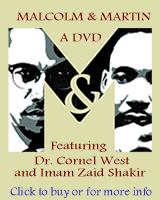 |
||||||||||||||
 |
||||||||||||||
 |
||||||||||||||
 |
||||||||||||||
| |
||||||||||||||
| |
||||||||||||||






















